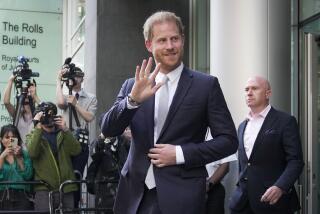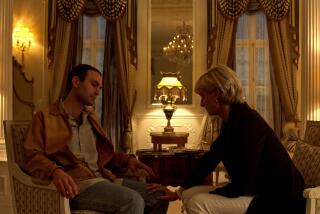Charges Dropped Against Paparazzi Implicated in Princess Diana Crash : France: Magistrates blame accident on limousine driver, who also died. They say he was drunk, under the influence of drugs and was driving too fast.
- Share via
PARIS — Two years after what must be the best-known car crash in recent history, French magistrates ruled Friday that a pack of pursuing paparazzi played no role in the accident that killed Britain’s Princess Diana and dropped proceedings against them.
The two magistrates instead placed the blame on the Frenchman who was at the wheel of the doomed Mercedes-Benz limousine. Henri Paul was legally drunk, had taken antidepressant drugs that weren’t supposed to be mixed with alcohol, and drove much too fast, they said.
“He was unable to control the vehicle, which was traveling at high speed, due to his state,” Investigating Magistrates Herve Stephan and Marie-Christine Devidal ruled.
Their decision means that there will be no trial, because Paul was killed in the crash.
Shortly after leaving the Ritz Hotel here in the early minutes of Aug. 31, 1997, the Mercedes 280 SE carrying Diana and her boyfriend, Egyptian playboy Dodi Fayed, slammed into a concrete pillar in a tunnel near the Seine River. Trevor Rees-Jones, a bodyguard, was the only survivor of the wreck. He suffered severe facial and chest injuries.
The princess of Wales was being pursued by photographers eager to get a picture of her and her new love interest. Some paparazzi even took pictures as she lay dying in the wreckage of the automobile, while one felt her pulse.
Widespread fury rose quickly at the idea that the paparazzi might have hounded the popular and beautiful princess to her death, coolly snapping photos as life ebbed from her. Nine photographers and a press motorcyclist were detained by police on suspicion of manslaughter and failing to come to the aid of Diana and the other passengers.
Stephan and Devidal censured the photographers for their conduct that night, saying in the ruling that “their behavior is an issue for them, and the people they work for, about the moral and ethical rules of their work.” But the magistrates ruled that the conduct “does not constitute a breach of penal law.”
For the photographers--who had been pilloried as vultures, often by their fellow journalists--the ruling was a long-awaited vindication.
“This decision of dropping proceedings is an immense relief and puts an end to two very trying years,” said Romuald Rat, photojournalist for the Gamma agency. Rat said he still has a hard time coping with the personal and professional fallout from Diana’s death.
“The photographers had no penal responsibility in the accident. This point is established,” said William Bourdon, lawyer for another photographer, Nicolas Arsov of the Sipa agency.
Fayed’s father, Egyptian billionaire Mohammed Fayed, almost immediately criticized the magistrates’ ruling. Mohammed Fayed has maintained that Diana and his son were victims of a plot because the British establishment could not tolerate the idea that the mother of the future British king might marry a Muslim or convert to Islam.
The elder Fayed, owner of Harrods department store in London and the Ritz in Paris, “still believes there was a conspiracy, and he has the will and the resources to pursue this as long as it takes,” representative Laurie Mayer said on Britain’s Sky television. “What we want is access to the intelligence files which we know are held by American and British intelligence, because the couple were monitored and closely followed for the last weeks of their lives.”
Under French law, Fayed is entitled to challenge the magistrates’ decision and have it reversed by an appeals court. Few expect a reversal.
Jean-Pierre Brizay, a lawyer for Paul’s family, also expressed “deep disappointment” with Friday’s ruling--which essentially places sole blame for the wreck on the driver. Brizay also said he might file an appeal.
The magistrates noted that forensic experts had established the speed of the four-door Mercedes when it hit the pillar at between 73 and 96 mph. Autopsy tests found that Paul had three times the legal limit of alcohol in his blood.
Putting an end to one of the case’s most tantalizing mysteries, the magistrates accepted police findings that a white Fiat Uno had only “brushed” the Mercedes from the rear at the entry to the tunnel, just before the crash. “The role of the vehicle was only passive,” Stephan and Devidal ruled.
The Italian-made car was never found despite an extensive nationwide search that led French police to check the owners of 40,000 Unos.
The magistrates followed prosecutors’ recommendations in not pursuing charges against the photographers. The magistrates said a series of decisions by the younger Fayed that night led Paul, who was off duty from his job with hotel security, to come to the Ritz and drive the couple. But they said Fayed could not be faulted for having made those decisions.
Diana’s brother, Earl Spencer, thanked French authorities for the two-year investigation and said he accepted the conclusions. A lawyer for bodyguard Rees-Jones also agreed with the magistrates’ findings.
“The report does not say directly that the Ritz is liable, but I believe the liability exists, either from Dodi or the Ritz,” said Christian Curtil, the bodyguard’s attorney.
A Buckingham Palace spokesman declined to comment. Diana’s death touched off a spasm of national grief and soul-searching in Britain. It also aroused negative feelings about other members of the royal family, who had ostracized the princess, and even about monarchy as a form of government. Two years later, such passions appear to have all but disappeared.
(BEGIN TEXT OF INFOBOX / INFOGRAPHIC)
Why Charges Were Dropped
Here are the main points of a statement by the Paris prosecutor’s office explaining why French judges dismissed all charges in the 1997 car crash that killed Princess Diana.
* The accident was not the result of a voluntary act.
* The accident resulted from the fact that driver Henri Paul was drunk and under the influence of antidepressants incompatible with alcohol.
* Paul’s state prevented him from controlling his vehicle at high speed on a difficult section of road while trying to avoid a slower vehicle going in the same direction.
* The fact that Paul was driving during his off-duty hours resulted from decisions by Dodi Fayed, but Fayed could not be criticized for making those decisions.
* The investigation did not establish any criminal fault by photographers at the scene, but their decision to take pictures at the crash site raised questions of morals and professional ethics.
Source: Associated Press
More to Read
Sign up for Essential California
The most important California stories and recommendations in your inbox every morning.
You may occasionally receive promotional content from the Los Angeles Times.










